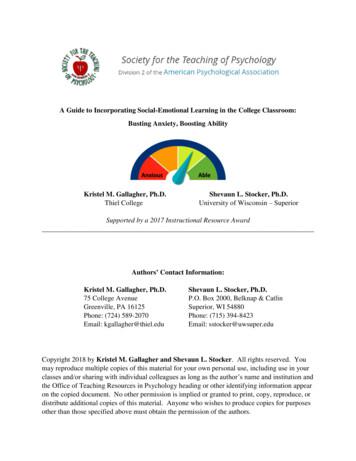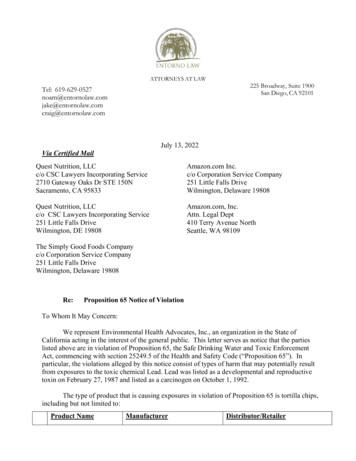Incorporating Inherent Safety Principles In Process Safety Management
Incorporating Inherent Safety Principles in Process Safety Management by Attiq Goraya, Paul Amyotte, Faisal Khan* Department of Process Engineering and Applied Sciences, Dalhousie University Halifax, NS *Faculty of Engineering & Applied Science, Memorial University of Newfoundland St. John's, NF
Outline Objectives Process Safety Management Elements of PSM Inherent safety Principles of inherent safety The need for incorporating IS in PSM Methodology Example: Incident Investigation Example: Management of Change Future work 10/29/2005 55th Canadian Chemical Engineering Conference, Toronto 16-19 Oct 2
Objectives Incorporate inherent safety principles in process safety management both qualitatively and quantitatively. 10/29/2005 55th Canadian Chemical Engineering Conference, Toronto 16-19 Oct 3
Process Safety Management Process Safety Management is the application of management systems to the identification, understanding and control of process hazards to prevent process related injuries and incidents (CCPS, 1989). The Center for Chemical Process Safety (CCPS) was formed by the American Institute of Chemical Engineers (AIChE) in 1985 to promote the improvement of process safety among those who handle, use, process, and store hazardous materials 10/29/2005 55th Canadian Chemical Engineering Conference, Toronto 16-19 Oct 4
Elements of Process Safety Management 1. 2. 3. 4. 5. 6. 7. 8. 9. 10. 11. 12. Accountability Process Knowledge and Documentation Capital Project Review and Design Procedures Process Risk Management Management of Change Process and Equipment Integrity Human Factors Training and Performance Incident Investigation Company Standards, Codes and Regulations Audits and Corrective Action Enhancement of Process Safety Knowledge 10/29/2005 55th Canadian Chemical Engineering Conference, Toronto 16-19 Oct 5
How we deal with hazards Engineered: Engineering features which reduce the frequency or mitigate consequences of the existing hazards. Procedural: Use of safe work practices or procedures to reduce the risk. 10/29/2005 55th Canadian Chemical Engineering Conference, Toronto 16-19 Oct 6
Inherent Safety From dictionary – inherent - Belonging to the very nature of a person or a thing. Characteristic of a design which prevents hazard or mitigate consequences 10/29/2005 55th Canadian Chemical Engineering Conference, Toronto 16-19 Oct 7
Principles of Inherent Safety The four main principles are Minimization Substitution Moderation Simplification 10/29/2005 55th Canadian Chemical Engineering Conference, Toronto 16-19 Oct 8
Inherent Safety Minimization: Minimize the hazard by reducing the quantity of the hazardous material. 10/29/2005 55th Canadian Chemical Engineering Conference, Toronto 16-19 Oct 9
Inherent Safety Substitution: Replacement of hazardous material or process with one that is less hazardous. 10/29/2005 55th Canadian Chemical Engineering Conference, Toronto 16-19 Oct 10
Inherent Safety Moderation: Moderation means using materials under less hazardous conditions. 10/29/2005 55th Canadian Chemical Engineering Conference, Toronto 16-19 Oct 11
Inherent Safety Simplification: Simplification means designing to avoid unnecessary complexity, thus reducing the opportunities for error and mis-opeartion. 10/29/2005 55th Canadian Chemical Engineering Conference, Toronto 16-19 Oct 12
The need for incorporating IS in PSM Although most companies that handle hazardous material have implemented process safety management, they are still having incidents 9Incorporation of inherent safety principles in the basic definitions of PSM elements, can improve the quality of PSM to a great extent. 10/29/2005 55th Canadian Chemical Engineering Conference, Toronto 16-19 Oct 13
PSM Elements Selected for IS Incorporation Process Risk Management Management of Change Process and Equipment Integrity Human Factors Training and Performance Incident Investigation Standards, Codes and Regulations 10/29/2005 55th Canadian Chemical Engineering Conference, Toronto 16-19 Oct 14
Methodology Qualitative: Identifying protocol Work-in Inherent Safety Checklist and Guidewords at both front and back end of the protocol. Quantitative: For quantitative part, the plan is to incorporate I2SI into one of the elements and also developing a new tool for one the elements. 10/29/2005 55th Canadian Chemical Engineering Conference, Toronto 16-19 Oct 15
Methodology Qualitative: – – – – – Management of Change Human Factors Training and Performance Incident Investigation Standards, Codes and Regulations Quantitative: – Process Risk Management – Process and Equipment Integrity 10/29/2005 55th Canadian Chemical Engineering Conference, Toronto 16-19 Oct 16
I2SI: Integrated Inherent Safety Index I2SI is guideword based indexing approach to measure inherent safety I2SI ISPI/HI – HI is hazard index; ranges values from 1 to 200 – ISPI is measures of the applicability of inherent safety principles; values ranges from 1 to 200 10/29/2005 55th Canadian Chemical Engineering Conference, Toronto 16-19 Oct 17
Investigation Methodology . Team Planning Incident Loss People Property Production Environment Notification to activate team Inherent Safety Guidewords Inherent Safety Checklist On-site Investigation Identification of Immediate Causes Identification of Basic Causes Lack of Management Control Factors Inherent Safety Guidewords Recommendations Implement Recommendations 10/29/2005 Position People Parts Paper 55th Canadian Chemical Engineering Conference, Toronto 16-19 Oct Follow Up Immediate/ Technical Avoid the hazard Improve Management System 18
Inherent Safety Guidewords Minimize: Use smaller quantities of hazardous materials when the use of such materials cannot be avoided. Perform a hazardous procedure as few times as possible when the procedure is unavoidable. Substitute: Replace a substance with a less hazardous material or processing route with one that does not involve hazardous material. Replace a hazardous procedure with one that is less hazardous. Moderate: Use hazardous materials in their least hazardous forms or identify processing options that involve less severe processing conditions. Simplify: Design processes, processing equipment, and procedures to eliminate opportunities for errors by eliminating excessive use of add-on (engineered) safety features and protective devices. 55th Canadian Chemical Engineering 10/29/2005 Conference, Toronto 16-19 Oct 19
Inherent Safety Checklist Guideword Minimize Substitute 10/29/2005 Checklist question Is the storage of all hazardous gases, liquids and solids minimized? Are just in time deliveries used when dealing with hazardous materials? Is shift rotation optimized to avoid fatigue? Can a less toxic, flammable or reactive material be substituted for use? Can a water based product be used in place of a solvent or oil based product? Is there an alternate way of moving product or equipment as to eliminate human strain? 55th Canadian Chemical Engineering Conference, Toronto 16-19 Oct 20
Inherent Safety Checklist Contd. Guideword Checklist question Moderate Can potential releases be reduced via lower temperatures or pressures, or elimination of equipment? Are all power tools de-energized when not in use for extended periods? Simplify Are all manuals, guides and instructional material clear and easy to understand, especially those that are used in an emergency situation? Are equipments or procedures designed such that they cannot be operated incorrectly or carried out incorrectly? 10/29/2005 55th Canadian Chemical Engineering Conference, Toronto 16-19 Oct 21
Management of Change Policies and procedures which ensure that change do not result in operations outside of established safety parameters Essential element is a plant’s process safety system Managing change can mean managing potential incidents 10/29/2005 55th Canadian Chemical Engineering Conference, Toronto 16-19 Oct 22
Main Types of Changes Change of Process Technology Change of Facility Organization Change Variance Procedures 10/29/2005 55th Canadian Chemical Engineering Conference, Toronto 16-19 Oct 23
Flowchart for Management of Change . Identify Need for Change Identify required review IS Checklist Conduct required hazard review IS Guidewords Take action to control hazards Obtain approval Implement Kelly (1996) 10/29/2005 55th Canadian Chemical Engineering Conference, Toronto 16-19 Oct 24
Flowchart for Management of Change . IS Guidewords Identify Need for Change Identify required review IS Checklist Conduct required hazard review IS Guidewords Take action to control hazards Obtain approval Implement Kelly (1996) 10/29/2005 55th Canadian Chemical Engineering Conference, Toronto 16-19 Oct 24
Future Work Case Study: Flixborough Vapor Cloud Explosion- fueled by release of 30 tons of cyclohexane Largest single loss by fire or explosion in the UK – Killed 28 people – Injured 89 others – 63 million in the property damage 10/29/2005 55th Canadian Chemical Engineering Conference, Toronto 16-19 Oct 25
Acknowledgements Dr. Paul Amyotte Dr. Faisal Khan Doug McCutcheon 10/29/2005 55th Canadian Chemical Engineering Conference, Toronto 16-19 Oct 26
. Questions and Suggestions 10/29/2005 55th Canadian Chemical Engineering Conference, Toronto 16-19 Oct 27
Elements of Process Safety Management 1. Accountability 2. Process Knowledge and Documentation 3. Capital Project Review and Design Procedures 4. Process Risk Management 5. Management of Change 6. Process and Equipment Integrity 7. Human Factors 8. Training and Performance 9. Incident Investigation 10. Company Standards, Codes and Regulations 11.
Safety Principles, Draft Safety Standard DS298 (June 2006). Safety Fundamentals: The Safety of Nuclear Installations, IAEA Safety Series No. 110 (1993). Defence in Depth in Nuclear Safety, INSAG-10 (1996). Basic Safety Principles for Nuclear Power Plants, 75-INSAG-3, Rev.1, INSAG-12 (1999).
Human Factors in Safety Job Safety Analysis Kitchen Safety Laboratory Ladder Safety Laser Safety Lead Lift Trucks Machinery & Equipment Miscellaneous Office Safety Paper Industry Personal Side of Safety Personal Protective Equipment Respirator Safety. Retail Safety Management Safety Talks Supervision Tools Trenching & Shoring
Laser Safety Training Laser Safety Offi cer Advanced Laser Safety Offi cer Principles of Lasers and Laser Safety Safety of Lasers Outdoors Laser Safety Masterclass Laser Safety for Art and Entertainment Measurements for Laser Safety Non-Ionizing Radiation ILSC 2015 Conference Agenda* Sunday, March 22 9:00am ASC Z136 Annual Meeting
the authors achieve this goal using a Bayesian network modeling approach incorporating physics-based priors. From a Bayesian perspective, our approach to integrating domain knowledge into the loss function is equivalent to adding it as a prior. In addition to incorporating domain knowledge,
social-emotional learning (SEL) as it is the basis for our program activities, and discuss the empirical evidence for the importance of incorporating SEL in the classroom. Finally, this section will help you understand how incorporating SEL-building activities into your course can
c/o CSC Lawyers Incorporating Service . 2710 Gateway Oaks Dr STE 150N . Sacramento, CA 95833 . . LLC . c/o CSC Lawyers Incorporating Service . 251 Little Falls Drive . Wilmington, DE 19808 . The Simply Good Foods Company . c/o Corporation Service Company . 251 Little Falls Drive . Wilmington, Delaware 19808 Amazon.com Inc. c/o Corporation .
A Beginner's Guide to Incorporating SAS Output in Microsoft Office Applications Vincent DelGobbo, SAS Institute Inc., Cary, NC ABSTRACT This paper provides techniques for incorporating the output from SAS software, regardless of the install platform, in Microsoft Excel and Word (versions 2000 and later). The paper focuses on
B.Sc in Gaming & Mobile Application Development Semester Sl. No Paper Code Subjects Credits Theory Papers T P Total First 1 ENG101 English 3 0 3 2 EMA102 Engineering Math 4 0 4























